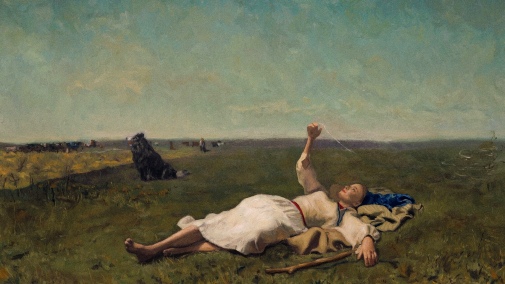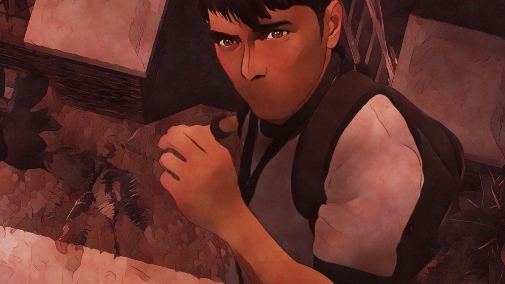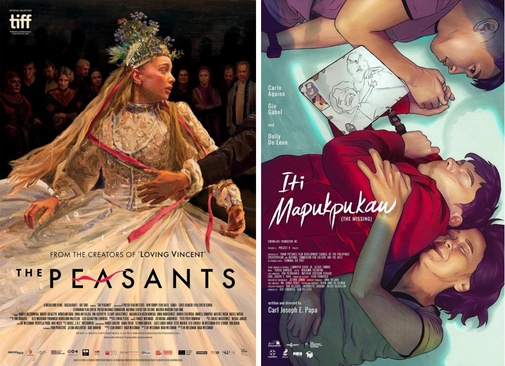As Guillermo del Toro loves to remind us, animation is cinema. It's not a genre but a medium with its own particularities and styles, distinct idioms, and formal grammar. This year, some countries have taken these values to heart, selecting animated works to represent them at the Oscars. Curiously, two of them offer original ways to consider Rotoscoping as an animation practice, defying those who dismiss such films as lesser. They are Poland's The Peasants, from the same team behind Loving Vincent, and The Missing from the Philippines. Between painterly ravishment and digital befuddlement, these filmmakers take Rotoscope cinema to its limits and beyond…

THE PEASANTS, DK Welchman & Hugh Welchman
With Loving Vincent, a new way of understanding Rotoscoped animation emerged. While working from live-action footage, effectively drawing over real human movement, the filmmakers made every frame a literal painting. In that Vincent van Gogh drama, 115 artists worked on 65,000 oil paintings, emulating the Dutch master's style to translate his subjectivity onto the screen. It felt like a revolutionary approach, imbuing every individual image with a palpable sense of manual effort, all the peculiarities of paint on canvas, its volume, textures. The hand of each painter is imprinted into the final film.
At a time of escalating AI usage, that feature remains a cry against the dehumanization of art. In the filmmakers' follow-up, The Peasants, that quality persists, though there's no stylistic through line in a single master's oeuvre. If one can find an artistic reference, it's to Jean-François Millet and his Realist colleagues, especially those of Young Poland. This leaves some of the picture's passages bereft of an aesthetic tenet beyond sheer beauty, though I'd argue that still has value on its own. Even if not always motivated, the technique can achieve great poetry when rapid motion is involved, and concrete depiction dissolves. When circling the dancing heroine, the camera philtered through oil paint can make her look on the verge of disintegration.
In the destruction of her form, style folds back into the story, bringing the narrative cruelties to a boiling point. Yes, this is a cruel tale about a young woman falling into bad choices and unjust societal pressures, gradually torn apart by the pit of vipers that call themselves her neighbors and community. It's all set in the village of Lipce, turn of the century Poland, across four seasons of ever-changing landscape. In there, beautiful Jagna falls for a married man but ends up sold in marriage to his father, tales of supposed promiscuity spreading like wildfire until her life's burnt to a husk. Adapting Władysław Reymont's Nobel Prize-winning novel, the Welchmans try to capture its simplicity while struggling to make sense of the characters.
Period alienation is at the center of the disconnect, for the behaviors of Jagna, her lovers and prosecutors, hinge on social mores born out of a specific place and time. Yet, one feels an attempt at modernizing the story to modern palates, including in the actors' work. In other words, they're too of the present day to convince us of the story's yesterday. Even visually, the problems arise in anachronism galore, most evident in the face of Kamila Urzedowska, who's always made up in a way that screams 2023. Painterly surfaces clash with these interpretative issues, making the misogyny depicted in the text feel aesthetized rather than adequately explored.
Individually, they are primarily minor problems. However, as they pile up and combine, metastasize into something larger, The Peasants crumbles under the weight. Watching it, I was reminded of Belladonna of Sadness, a similarly-themed anime masterpiece where director Eiichi Yamamoto took stylization a few steps further. But there, it was so extreme that the past's essential foreignness manifested in the distance between the audience and the characters. In The Peasants, that threshold is never overcome. And yet, all misgivings aside, the film's still a worthy watch, its dance scenes a marvel, and the score an Oscar-worthy triumph. Indeed, any music ballot that overlooks Lukasz Rostkowski's compositions should be judged null and void.

THE MISSING, Carl Joseph E. Papa
If you prioritize beauty in animation, then maybe The Missing is not for you. At its worst, the Filipino genre mishmash is downright unpleasant to look at, wavering between Rotoscope realism and childish scribbles in computerized crayon. However, every choice feels deliberate, the weirdness another weapon in a vast arsenal where something as simple as the framerate can turn into a sentimental wallop. Stylistically, while the relative realism of one approach invokes the present experience, the other deals with memory. Learning to appreciate these dichotomies is to learn how to watch The Missing.
As someone not especially fond of Rotoscoped films, Carl Joseph E. Papa's work reminded me of what the technique can do, its unique advantages and quirks. In this context, The Missing is a testament to the art of animation and all the form's possibilities, using it to crystalize human truths in ways traditional live-action couldn't. Fittingly, it's the story of an animator, Eric, who lives alone and whose social life seems reduced to video calls from his mother and some awkward tenderness with a coworker. It's a quiet existence, and everything seems normal except for one detail – he has no mouth.
The space where it should be doesn't just look empty. It appears erased, as if some celestial hand smudged the drawing. One can practically picture a giant thumb pressing into lips until they're a skin-colored blur. Or mayhap a snatching thief, ripping the feature without leaving so much as a scar behind. Apart from commenting on his muteness, nobody around Eric notices this bizarre detail. And so, mundanity continues as it always has until a visit to his uncle's house provides a shock to the system. The older relative is dead, body rotting for days and covered in flies. Not only that, when Eric goes outside to catch his breath, a light from above pulls him up. It's an alien.
From then on, whatever semblance of reality might have been established dissolves, with the childish style of animation intruding upon the present with increasing intensity and contradictions. The aliens are there in the past, but so is the uncle, his face covered in black chicken scratch. In the now, after Eric's mouth, an eye comes off, then an ear, a hand, and there go the genitals, too. Reckoning with whatever secret's hidden in his childhood, Eric's materiality is stolen from himself, with trauma acting as a mutilating gesture from beyond our world. But what if this void doesn't come from outside? What if it's from within, pulling one into nothingness?
The metaphor can feel heavy-handed, but it proves flexible through tonal transformations. Sometimes, there's a burst of such odd imagery you can't help but laugh before the meaning behind it leaves you sick. This push-and-pull is an internal process exteriorized, and The Missing does much to keep unnecessary conflict out of the way. Eric's mother and coworker crush are beacons of support, understanding to the point of saintliness as they keep the young man afloat on his journey to catharsis. He shall find it at the bottom of a grave. Unearthing it is a revelation of painful truth, and healing oneself is finding one's voice. It's logical that the film ends in that instant, pitch-perfect when you think about it.
Not that The Missing requires much intellectualization. For all its complexity, it's an exercise that lives and dies in the viewer's emotional response, a primordial kind of cinema. The framerate matter, for example, works by inspiring discomfort during the flashbacks to Eric's boyhood. The rusty movement almost makes you feel constricted, as if you're being held down and can't breathe. Later, in the backseat of a car, ghosts of the past come to the front, the disjointed styles and speeds transmitting a visceral wrongness. As messy and ugly as it can be, The Missing is the kind of cinema you feel in your gut, that breaks your heart and puts it back together again.
If the review whetted your appetite for The Missing, check out Juan Carlos Ojano's interview with the director of this queer gem and one of its actors.
